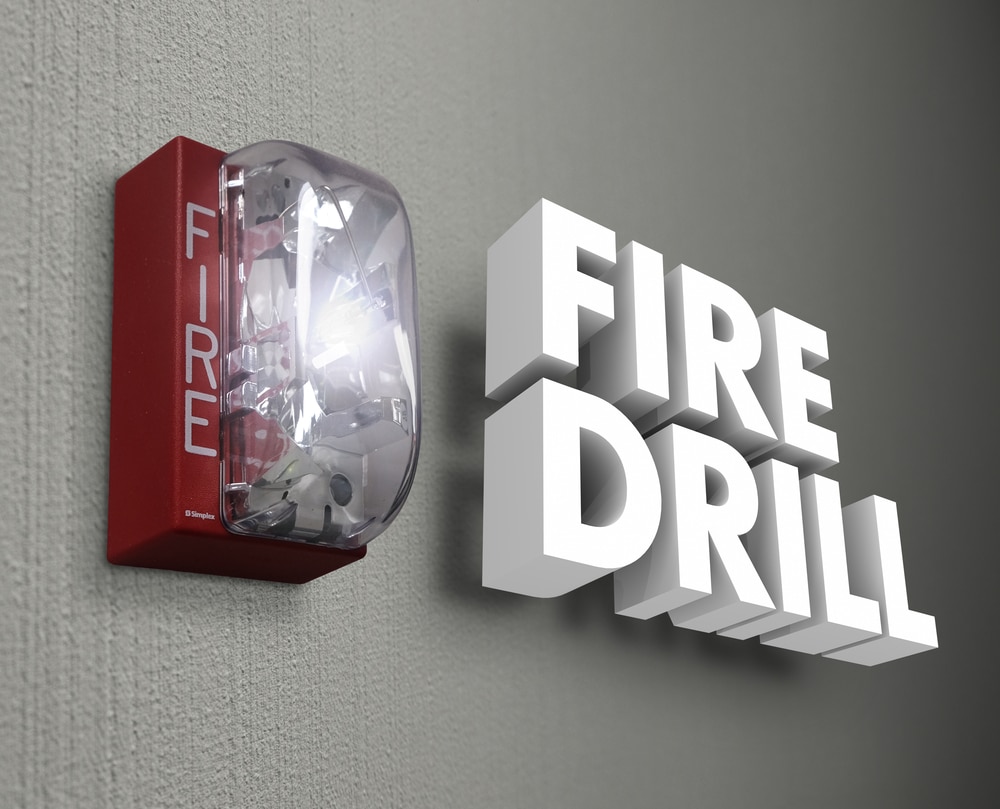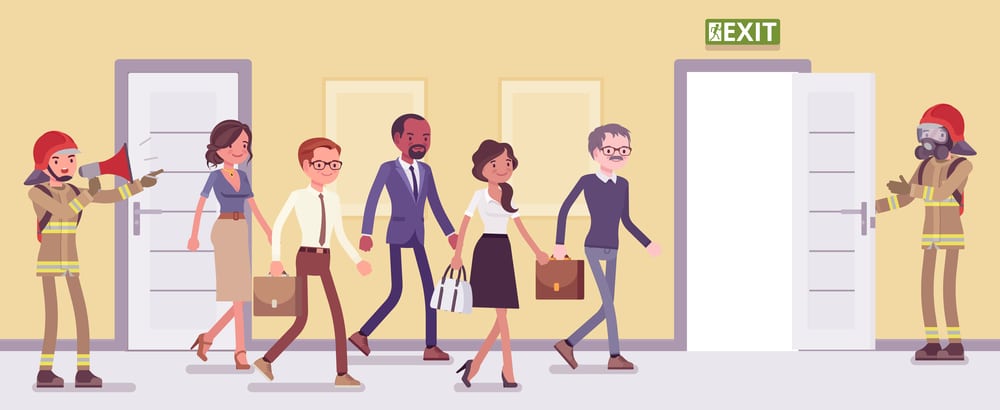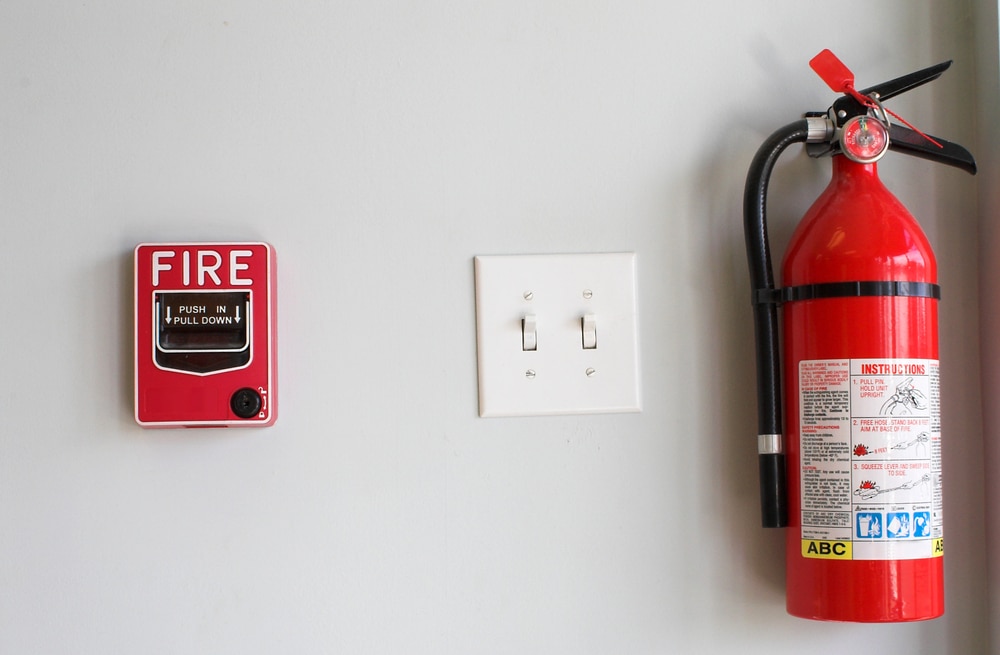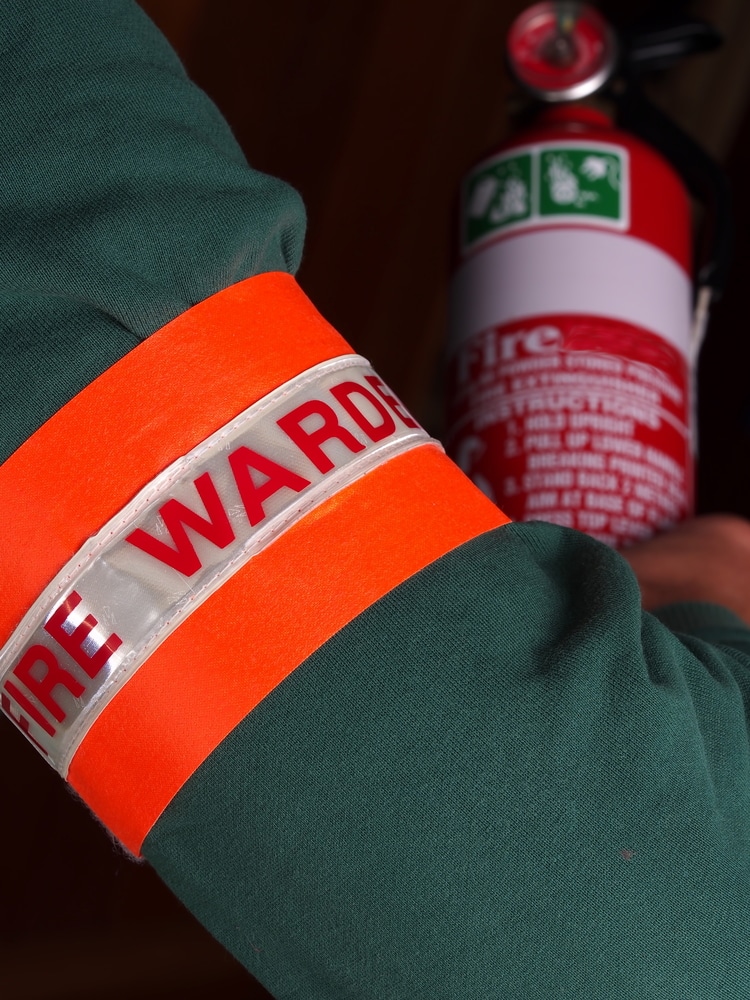Best Practices for Conducting Effective Evacuation Drills

In workplace safety, few practices hold as much potential for saving lives and minimizing risk as emergency evacuation drills.
Picture this: a bustling office building suddenly transformed into a quiet exodus of employees, each moving in an orderly manner towards designated doors and exit points. The urgency in their movements is not fueled by panic but rather by a well-rehearsed routine born from meticulous planning and preparation.
Fire drills, a subset of evacuation protocols, are a steadfast guardian against the unpredictable threat of flames and smoke, ensuring that employees can navigate the chaos.
This blog post delves into the crucial realm of building evacuation drills, focusing on fire-related scenarios. Beyond mere compliance, these drills cultivate a culture of preparedness, empowering individuals to act decisively and responsibly in emergencies.
You should also check out our Employee Evacuation Training program if you need to train your staff.
What Is a Fire Drill?
At its essence, fire evacuation drills are meticulously choreographed rehearsals for one of the most critical scenarios a workplace may encounter – a fire outbreak. They are a proactive strategy to safeguard lives and assets.
Employees practice swift and orderly movement from workstations to designated fire exits during a fire drill. This orchestrated exercise serves to familiarize individuals with escape routes, fire safety equipment, and assembly areas, ensuring an organized response in an emergency.

The Importance of Conducting Regular Fire Drills
When it comes to safeguarding workplace environmental health, the age-old adage “practice makes perfect” holds steadfast, especially when it comes to fire drills. In fact, regular evacuation and fire drills can make your business a safer place for employees, customers, and business owners.
Regularly conducting fire drills is a cornerstone of a comprehensive emergency preparedness strategy. These rehearsals transcend theoretical knowledge, forging a tangible connection between knowing what to do and seamlessly executing those actions under pressure.
Firstly, fire drills imprint a mental map of escape routes, extinguisher locations, and assembly points, fostering an instinctual response that bypasses panic. Secondly, these drills facilitate team coordination, nurturing a unified approach that prevents bottlenecks and ensures everyone’s safe egress.
In addition to meeting workplace safety requirements, the regular practice of fire drills nurtures a sense of alertness among employees, encouraging them to take an active role in safeguarding both their well-being and that of their coworkers.
Conducting drills also safeguards the buildings themselves. Data from the National Fire Protection Association (NFPA) reveals that between 2007 and 2011, an average of 3,340 fires were attended to by fire departments annually, leading to property damages exceeding $112 million each year.
In no uncertain terms, establishing fire drill procedures can be the difference between all building occupants walking out and unimaginable tragedy.

Preparing for Evacuation Drills
Risk Assessment & Scenario Planning
Anticipating the unforeseen lies at the core of impeccable evacuation procedures and constant vigilance.
Initiate this process by meticulously identifying potential hazards and emergencies unique to your surroundings, whether it’s the intricate layout of your building or the materials employed, a comprehensive risk assessment charts the course for effective preparation.
Next, delve into the realm of realistic evacuation scenarios. Craft situations that mirror reality, honing your team’s ability to navigate adversity. Examine various exit routes, simulate obstructions within the building, establish an assembly point, and factor in time-sensitive elements to elevate the authenticity of each drill.
Fire Alarm System and Communication Procedures
Seamless fire evacuation drills hinge on robust fire alarm systems and clear communication protocols.
The fire safety alarms, meticulously maintained and strategically placed, serves as the sentinel that alerts your workforce to potential dangers within the building. The piercing tones of a fire alarm are universally understood and prompt swift action within the facility.
Communication procedures further amplify the system’s efficacy. Designated individuals assume the role of communicators, relaying vital information through well-established channels.
Finely tuned protocols ensure that employees receive accurate instructions, facilitating their orderly movement toward leaving the building safely.

3 Steps to Running a Successful Emergency Evacuation Drill
1. Developing an Exhaustive Evacuation Plan
Crafting an effective evacuation drill commences with a comprehensive evacuation plan meticulously tailored to your workplace’s unique layout and operational nuances. This blueprint ensures a well-coordinated response when the unexpected strikes.
Here’s what a fire drill assessment should entail in most buildings:
- Identify primary and alternative emergency exits.
- Strategically position emergency equipment such as smoke detectors, fire extinguishers, nearest exit signs, and assembly point markers.
- Assign specific roles and responsibilities to key personnel who will guide others during the evacuation.
Regularly review and update your evacuation plan with any changes to your building or workforce. This dynamic document serves as the foundation for successful fire drills and helps you further cultivate a workplace safety culture if the time comes.

2. Training Your Employees and Fire Warden
Effective execution of a fire drill hinges on well-prepared employees and a capable fire warden.
Training is the linchpin of this dynamic, ensuring that each individual comprehends their role during a fire drill. This entails imparting knowledge on evacuation routes, every assembly point within and outside the building, and proper usage of fire safety equipment.
This crucial step equips employees with the confidence to act decisively for simulated fire drills and real fire safety hazards, fostering a collective response that minimizes chaos.
The fire warden, an essential figure, requires specialized training to conduct the drill seamlessly. They guide, instruct, and oversee evacuating, offering a steady hand amid potential turmoil.
3. Time to Conduct Drills and Track Results
Executing a successful emergency evacuation drill demands precision and thoroughness.
Assemble your designated drill team, comprising individuals well-versed in emergency procedures and equipped to guide others. Before all fire drills, disseminate clear instructions to participants, emphasizing the importance of a focused and realistic approach.
Once the evacuation drill is underway, observe the unfolding scenario closely. Note how efficiently and safely your building occupants evacuate to the designated assembly point, the timeliness of the alarm activation, adherence to established escape routes, and the effectiveness of communication.
Beyond the drill’s conclusion, meticulous record-keeping becomes paramount. Document response times, assess any deviations from protocol, and gather participant feedback. These insights, valuable as they are, determine the foundation for continuous improvement.
Once you conduct your first fire or other emergency drill, schedule regular fire drills during different periods, whether during normal business hours, after-hours, or before your building’s doors open.

Final Thoughts
In the ever-evolving landscape of workplace safety, the significance of building exodus drills remains resolute.
These orchestrated exercises transcend compliance, becoming a testament to proactive readiness and unwavering commitment to employee well-being.
Frequently Asked Questions
What are the different types of evacuation drills?
Different types of drills cater to various scenarios in a building or office setting.
- Fire drills, the most common, prepare occupants for blazes.
- Emergency drills encompass broader situations, like natural disasters or hazardous materials incidents.
- Lockdown drills train occupants to respond to threats within a (usually) secure location.
Does OSHA require evacuation drills?
OSHA mandates fire drills under its fire code standards.
Buildings and employers must regularly conduct drills in office buildings and other workplaces to prepare occupants for emergencies, including fires. These drills must simulate special circumstances and cover various scenarios, ensuring everyone knows escape routes, assembly points, and how to respond.
The employer has to develop, schedule, and conduct these drills, assigning designated personnel to assist and guide participants.
What are the five steps evacuation plan?
If an evacuation drill plan had to be boiled down into five steps, here’s what it would look like:
- Develop a comprehensive emergency strategy encompassing shelter locations and employee duties.
- Implement an alert system to notify individuals during emergencies swiftly.
- Regularly test the plan through fire drills, assessing efficiency and adapting as needed.
- Establish a clear communication protocol to aid in employee assistance and health.
- Prepare an assembly location (or two) for safe reunification.
In this distilled blueprint, the critical aspects of planning, communication, testing, and employee well-being converge to ensure a resilient and effective evacuation system.